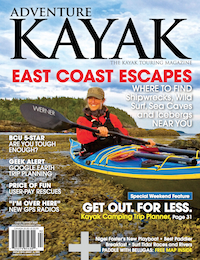For me there’s a certain ritual associated with heading out to kayak surf. There’s the obsessive monitoring of online wave plot predictions, winds and tides. And the spirited debates and often ridiculously over- optimistic hopes about what day will yield the best surf. Authoritative predictions are made, and then come the day, the traditional early morning phone calls and emails crisscross our little surfing community as we make the final call—do we risk the long drive in hope of surf? Or do we abort in favour of going sea kayaking closer to home, running a river or (gulp) doing yard work?
I’ve been paddling the surf breaks that form at the mouth and point at Jordan River on southern Vancouver Island since the early ‘90s. Jordan river is about one and a half hours’ drive from Victoria—out past the community of Sooke—on the island’s west coast. Its proximity to victoria has made it a very popular destination with an ever-growing number of board surfers, as well as a handful of misguided souls (like me) who kayak surf.
Now Jordan river and a huge chunk of land that stretches along that section of coast is threatened by major development. Despite very vocal opposition from the public, it’s unclear what the fate of the land and the surf break will be. The dispute dates back to January 2007, when the provincial government gave a logging company, Western Forest Products (WFP), approval to release 28,000 hectares of its private land from management under the province’s Tree Farm License system. The decision allows WFP to sell the land—including the Jordan River area—for corporate profit. A Vancouver-based developer has plans for 2,550 hectares, including a village of 10,000 residents at Jordan River, a marina and hundreds of rural lots.
The province’s auditor general, John Doyle, said in a July 2008 report that the decision to release the land was made without due consideration for the public interest. Due to pressure from environmental organizations and the public, the regional government put in a new bylaw that requires a minimum lot size of 120 hectares for most of the area. The bylaw also restricts the subdivision of existing lots into anything smaller than 10 acres. This is staving off major development for the moment, but WFP and the Association of B.C. Landowners have challenged it in court.
Perhaps the potential loss of one surf break on Vancouver Island doesn’t sound very important. Maybe it seems irrelevant. But look at it this way: Jordan River is the canary in the coal mine alerting us to the pressures on our favourite backcountry paddling destinations. If we paddlers do nothing to manage expansion as our population grows and urban sprawl sprawls, it is not a question of if each of us will lose one of our favourite paddling destinations, but when.
In B.C., an incredible number of waterways have been targeted for small independent power production. The amazing Okisollo rapids and Surge narrows off of Quadra Island were recently threatened by a hydro project. In the face of strong opposition, the provincial government announced the cancellation of both applications. Great news, but don’t celebrate too long because not very far away, another proposal is threatening the beautiful mainland watershed in Bute Inlet.
This summer, as I paddled Vancouver Island’s west coast from Port Hardy round Cape Scott and the Brooks Peninsula, it struck me how many campsites we use through convention and the good graces of their custodians, rather than by permission or any formal land use agreement. Much of the coast south of the Brooks, for instance, is subject to land claims from First Nations. Our access is a privilege, not a right, and despite the reassuring presence of all the sites listed in guidebooks and on maps, in truth we could lose access very easily. The clock is ticking.
Unless we start to give some thought to preserving the areas that we love to visit by kayak and act to establish land use agreements that support marine trail systems (such as the ambitious B.C. Marine Trail concept), we may find that touring possibilities become very restricted. The loss of just a few strategically placed campsites can make linking many kayaking routes unsafe or virtually impossible for the average paddler.
Of course expansion and development is not all bad and hydroelectric power generation is a necessity for our power-hungry lifestyles. But I for one want to try and help steer development so that it happens within a carefully considered, publicly approved plan and timeframe, that protect as many green places as possible. Because when it comes to making shopping malls, radial tires and light bulbs, we humans are fantastic. But we suck at building a dragonfly, grizzly bear, gnarled pine tree or a pristine stretch of coastline.
Now I’m going surfing. While I still can.
Alex Matthews would rather be out paddling. He recently organized a paddlers’ rally to oppose a mega-yacht marina in Victoria’s harbour.




